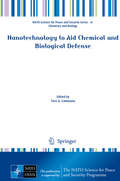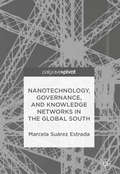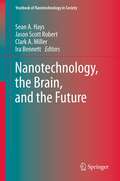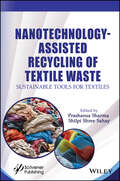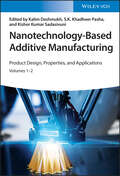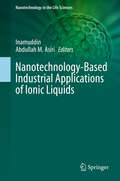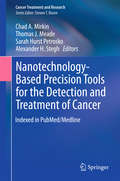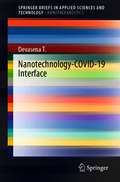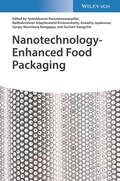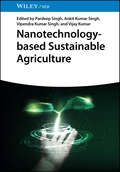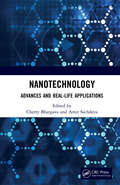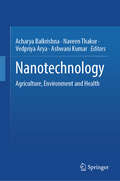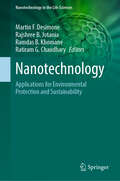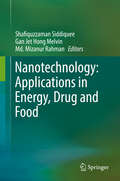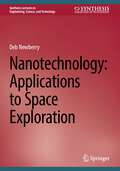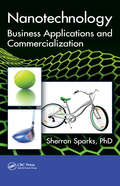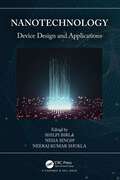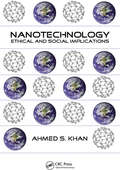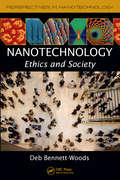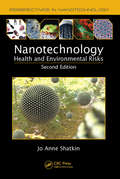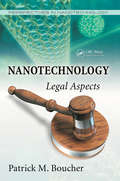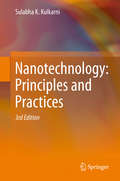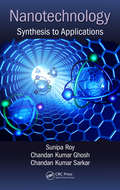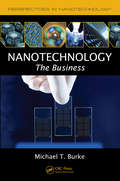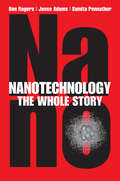- Table View
- List View
Nanotechnology to Aid Chemical and Biological Defense
by Terri A. CamesanoThis book presents research into chemical, biological, radiological and nuclear (CBRN) defense and environmental security, exploring practical implications of the research. Contributions from a diverse group of international civilian researchers present the latest work on nanotechnology problems in this area, looking at detection, protective technologies, decontamination and threats to environmental security due to bacteriophages and nanomaterials. Highlights include the potential of Atomic Force Microscopy (AFM) to characterize the nanoscale properties of microbial pathogens, the development of bacteriophage-based therapeutics, prophylactic and diagnostic preparations and their uses in different fields, such as medicine, veterinary, agriculture, food and water safety, amongst others. Readers may also consider an inexpensive bioassay suited for assessing chemical poisoning in the environment such as the presence of pesticides, sensors to detect ultra-trace quantities of the explosive Pentaerythritol tetranitrate (PETN) using nanotubes and electrochemical sensors to simultaneously detect and reduce the explosive trinitrotoluene (TNT) to 2,4,6-triaminotoluene (TAT) in solution. This book shows how cooperative research among NATO countries and NATO partners can make a critical contribution to meeting the opportunities and challenges of nanotechnology problems relevant to chemical and biological defense needs. The papers presented here are representative of contributions made to the Advanced Research Workshop (ARW) on September 22-26, 2014 in Antalya, Turkey, to address the NATO SPS Key Priority of Defense against CBRN Agents and Environmental Security.
Nanotechnology, Governance, and Knowledge Networks in the Global South
by Marcela Suárez EstradaThe seemingly unlimited technological potential of nanotechnology brings with it new practices of governance, networking, and exercising power and agency. Focusing on scholars in the Global South, this text covers nanotechnology discourses, imaginaries, and materialities as they circulate and interact within governance knowledge networks. Rather than adapt their actions to existing governance mechanisms and science, technology, and innovation policy, scientists use the imaginary of nanotechnology to create new symbolic and material incentives, thus shaping its governance. By tracing the constantly shifting asymmetries of knowledge and power, the book offers fresh insights into the dynamics of knowledge networks.
Nanotechnology, the Brain, and the Future
by Jason Scott Robert Sean A. Hays Clark A. Miller Ira BennettOur brain is the source of everything that makes us human: language, creativity, rationality, emotion, communication, culture, politics. The neurosciences have given us, in recent decades, fundamental new insights into how the brain works and what that means for how we see ourselves as individuals and as communities. Now - with the help of new advances in nanotechnology - brain science proposes to go further: to study its molecular foundations, to repair brain functions, to create mind-machine interfaces, and to enhance human mental capacities in radical ways. This book explores the convergence of these two revolutionary scientific fields and the implications of this convergence for the future of human societies. In the process, the book offers a significant new approach to technology assessment, one which operates in real-time, alongside the innovation process, to inform the ways in which new fields of science and technology emerge in, get shaped by, and help shape human societies.
Nanotechnology-Assisted Recycling of Textile Waste: Sustainable Tools for Textiles
by Prashansa Sharma Shilpi Shree SahayDiscover how innovative nanotechnology can turn waste into opportunity, offering insights and strategies to create a greener, more eco-friendly textile industry. This book investigates nanotechnology-assisted sustainable solutions and their potential to transform waste into opportunity by fostering innovative designs and in-depth knowledge of sustainable waste management and nanotechnology applications. Divided into four comprehensive parts, comprising 16 chapters, Nanotechnology Assisted Recycling of Textile Waste, provides insights into the potential of nanotechnology in revolutionizing textile recycling and shaping the future of sustainable textiles. Part I sets the stage with an insightful overview of textile waste and management, exploring the conceptual dimensions and challenges in handling and organizing textile waste. It also describes the innovative realm of textile recycling. In Part II, the spotlight shines on comprehensive, sustainable, and productive recycling of waste using nanotechnology. Here, readers are invited to explore the transformative contributions of nanotechnology in shaping sustainable textile design and characterizing functional properties of novel recycled nano-textiles. Future perspectives of nanotechnology in textile applications, particularly concerning waste recycling, are also examined. Part III explores deeper into the advanced application of recycled and nano-assisted novel textiles generated through waste. From sports textiles to technical textiles, this section explores the diverse applications of recycled waste, bolstered by nano-engineered innovations. Finally, Part IV addresses the critical aspects of quality control and regulatory compliance in the realm of advanced nano-textile materials through an exploration of global legislation, schemes, and standards. Readers will find in this book: research findings and innovative approaches to cope with the challenges and issues of textile waste; systematic and scientific knowledge on textile waste recycling techniques using nanotechnology; knowledge of complex scientific research findings in a simple and understandable form; comprehensive coverage of a broad range of topics, including sustainable textile waste management. Audience The book will be read by a range of researchers, engineers and students in technical textiles, textile technology and engineering, textile chemistry, fiber science, textile processing technologies and manufacturing, fashion and apparel technology, materials science, environmental science. This book will help designers and clothing manufacturers, and all those in textile and environmental domains, who are engaged in waste management.
Nanotechnology-Based Additive Manufacturing: Product Design, Properties, and Applications
by Kalim DeshmukhNanotechnology-Based Additive Manufacturing State-of-the-art overview of additive manufacturing techniques with an emphasis on processes, product designs and applications This book offers a thorough overview of additive manufacturing technologies, including manufacturing requirements, product design, optimization of processes and product parameters to reduce manufacturing costs. It provides a comprehensive and state-of-the-art review on various additive manufacturing technologies, their advantages, shortcomings, potential applications and future directions. Sample topics discussed by the three well-qualified editors on the topic of additive manufacturing include: Areas of application in the fields of electronics, aerospace, construction, automobile, sports and biomedicine Material considerations, the requirement of specific design, fabrication and processing methods Advantages and disadvantages of various 3D printing techniques for the respectively intended applications This book is an immensely valuable resource for researchers working in the field of additive manufacturing or 3D printing, or for developers dealing with the processing and manufacturing of materials and products for advanced technologies.
Nanotechnology-Based Industrial Applications of Ionic Liquids (Nanotechnology in the Life Sciences)
by Inamuddin Abdullah M. AsiriNumerous solvents used in chemical processes have poisonous and unsafe properties that pose significant ecological concerns ranging from atmospheric emissions to the contamination of water effluents. To combat these ecological threats, over the course of the past two decades, the field of green chemistry has grown to develop more natural reaction processes and techniques involving the use of nonconventional solvents to diminish waste solvent production and thus decrease negative impact on the environment. Ionic liquids in particular are more environmentally friendly substitutes to conventional solvents, and as such, have seen more widespread use in the past decade. They have been used in such processes as extraction, separation, purification of organic, inorganic, and bioinorganic compounds, reaction media in biochemical and chemical catalysis, green organic and drug synthesis, among other industrial applications. Thus, in proving themselves a suitable greener media for economic viability in chemical processes, ionic liquids are leading to more sustainable development. This edition explores the application of ionic liquids as a green solvent. It contains a state-of-the-art overview on ionic liquids as green solvents for chemical processes and techniques, as well as some of their useful industrial applications.
Nanotechnology-Based Precision Tools for the Detection and Treatment of Cancer
by Chad A. Mirkin Thomas J. Meade Sarah Hurst Petrosko Alexander H. SteghThis book discusses emerging nanotechnology-based tools that have the potential to dramatically impact cancer research, diagnostics, and treatment. Cancer is a complex, devastating, and debilitating disease and, although much progress has been made, novel, more effective diagnostic and treatment options are still needed, especially for advanced cancers. The ultimate goal is to detect cancer early and non-invasively and to provide efficacious and targeted precision treatments that cause fewer harmful side effects. This book explains how nanotechnology can exploit the size-, shape-, and composition-dependent properties of nanomaterials to provide novel tools for precision cancer medicine. It will be of interest to researchers and professionals working in the fields of chemistry, biology, materials science and engineering, and medicine who want to learn more about this fascinating and fast-paced area of research.
Nanotechnology-COVID-19 Interface (SpringerBriefs in Applied Sciences and Technology)
by Devasena T.This book highlights the role of nanotechnology concepts in the management of COVID-19 pandemic. The book covers different aspects of the causative agent SARS CoV2 (Severe Acute Respiratory Syndrome Coronavirus-2) and the COVID-19 pandemic with a special emphasis on nanotechnology. It discusses the origin and history of SARS CoV2 and the outbreak of COVID-19 and highlights the geographical mutations in the SARS CoV2 virus genome, providing information about the structural features, antigenicity and the life cycle of SARS CoV2. The book provides an insight into nanotechnology–virology interface and explains how nanomaterials link the gap between the vital phases of SARS CoV2 life cycle and the four modalities of COVID-19 management viz sensing/diagnosis, therapy, prevention and self-protection. Further, the existing and promising diagnostic tools for detection of COVID-19 are discussed with an emphasis on nano PCR, nanoimmunosensors, biobarcode assay and point of care approach and also describe the nanoparticles involved in the CT imaging of lungs and SFHI (Spatial Frequency Hetrodyne Imaging) for diagnosis of SARS COV2 infection. The book concludes with details about translational medicine and explains the types of SARS CoV2 vaccines, stages of COVID-19 vaccine development and possible nanovaccines for COVID-19, followed by the description on biopharmaceutical companies involved in the production of SARS CoV2 vaccines.
Nanotechnology-Enhanced Food Packaging
by Jyotishkumar Parameswaranpillai Suchart Siengchin Sanjay Mavinkere Rangappa Aswathy Jayakumar Radhakrishnan Edayileveettil KrishnankuttyNanotechnology-Enhanced Food Packaging Timely overview of functional food packaging made with nanotechnology and nanomaterials In Nanotechnology-Enhanced Food Packaging, a distinguished group of researchers delivers a comprehensive and insightful introduction to the application of nanomaterials in food packaging. This edited volume covers recent innovations—as well as future perspectives—in the industry and offers a complete overview of different types of nanomaterials used in food packaging. The book also discusses the use of nanoparticles in the development of active and functional food packaging and the related environmental and toxicological aspects. Featuring one-of-a-kind contributions from leaders in the field, Nanotechnology-Enhanced Food Packaging provides real-world solutions to food packaging challenges and considers the legislative and economic implications of new technologies. Among the new developments in nanotechnology-enhanced food packaging covered by the book are: Thorough introduction to biopolymers in food packaging systems and nanostructures based on starch, their preparation, processing, and applications in packaging Comprehensive explorations of chitosan-based nanoparticles and their applications in the food industry Practical discussions of active packaging systems based on metal oxide nanoparticles and an overview of higher barrier packaging using nano-additives In-depth examinations of the characterization techniques for nanostructures in food packaging Perfect for materials scientists, food technologists, and polymer chemists, Nanotechnology-Enhanced Food Packaging also belongs on the bookshelves of plastics technologists and allied professionals in the food industry.
Nanotechnology-based Sustainable Agriculture
by Vijay Kumar Pardeep Singh Ankit Kumar Singh Vipendra Kumar SinghProvides detailed guidance on harnessing nanotechnology for sustainable agriculture, combines theoretical frameworks with actionable strategies Nanotechnology-based Sustainable Agriculture offers an in-depth exploration of how nanotechnology is revolutionizing agricultural practices to enhance crop productivity and environmental sustainability. Addressing key challenges in conventional agriculture, this volume presents the cutting-edge roles of various nanomaterials, such as carbon nanotubes and quantum dots, in boosting efficiency and reducing environmental impact. Emphasizing practical solutions, ranging from nano biofertilizers and nanobioremediation to innovative pest control strategies, an expert panel of authors provides a roadmap for integrating nanotechnology into sustainable agricultural systems. In-depth chapters describe both the fabrication of nanomaterials and their application in soil quality assessment, pollutant remediation, and crop disease management. Throughout the text, the authors highlight opportunities and address challenges to ensure the safe and effective adoption of these technologies. Enhancing crop productivity and environmental health through innovative solutions, Nanotechnology-based Sustainable Agriculture: Explores a wide range of nanotechnologies for use in agriculture, including plant-based nanomaterials, chitosan nanoparticles, and silver nanoparticlesPresents strategies for minimizing environmental and health impacts while maximizing crop productivityIncorporates the latest developments in nanobiotechnology, phytonanotechnology, and nano-bioremediationDiscusses the challenges and potential risks of nanomaterial-based chemicals in agricultural systemsExamines diverse case studies and strategies to achieve food security and sustainable agriculture on a global scale Nanotechnology-based Sustainable Agriculture is essential reading for advanced students, researchers, and professionals in environmental science, material science, and agriculture. It is well-suited as a textbook for graduate and postgraduate courses in sustainable agriculture or nanotechnology, as well as a reference for professionals in research and development, policymaking, and industry.
Nanotechnology: Advances and Real-Life Applications
by Cherry Bhargava and Amit SachdevaNanotechnology: Advances and Real-Life Applications offers a comprehensive reference text about advanced concepts and applications in the field of nanotechnology. The text – written by researchers practicing in the field – presents a detailed discussion of key concepts including nanomaterials and their synthesis, fabrication and characterization of nanomaterials, carbon-based nanomaterials, nano-bio interface, and nanoelectronics. The applications of nanotechnology in the fields of renewable energy, medicine and agriculture are each covered in a dedicated chapter. The text will be invaluable for senior undergraduate and graduate students in the fields of electrical engineering, electronics engineering, nanotechnology and nanoscience. Dr. Cherry Bhargava is an Associate Professor and Head, VLSI domain, at the School of Electrical and Electronics Engineering of Lovely Professional University, Jalandhar, India. Dr. Amit Sachdeva is an Associate Professor at Lovely Professional University, Jalandhar, India.
Nanotechnology: Agriculture, Environment and Health
by Ashwani Kumar Acharya Balkrishna Naveen Thakur Vedpriya AryaThis book presents an update on the state of the art in nanobiology and various nanoparticle synthesis and characterization methods. Further, the application of nanomaterials in agriculture (nanobiofertilizers and nanobiopesticides), environmental remediation (bio-nanoaugmentation), and public health (diagnosis, treatment, and drug delivery) is also a key area of this book. This book serves as a roadmap for researchers to fill various gaps by designing and organizing future research. It offers a crucial reference for academic researchers in nanotechnology, medicine, material science, toxicology, agriculture, environmental science, and biomedical science.
Nanotechnology: Applications for Environmental Protection and Sustainability (Nanotechnology in the Life Sciences)
by Martin F. Desimone Rajshree B. Jotania Ramdas B. Khomane Ratiram G. ChaudharyNanotechnology has the potential to revolutionize the way we address environmental challenges. From water purification, renewable energy, and pollution remediation, nanomaterials offer new and innovative solutions to some of the most pressing problems facing our planet. This book discusses the latest advances in nanotechnology and its potential applications for environmental protection and sustainability. The book covers a wide range of topics, from the fundamental principles of nanotechnology to specific case studies of nanomaterials being used to solve real-world environmental problems. This book is intended for researchers, students, professionals, and policymakers.
Nanotechnology: Applications in Energy, Drug and Food
by Shafiquzzaman Siddiquee Gan Jet Hong Melvin Md. Mizanur RahmanApplications of nanotechnology are the remarkable sizes dependent on physiochemical properties of nanomaterials that have led to the developed protocols for synthesizing nanomaterials over a range of size, shapes and chemical compositions. Nanomaterials are normally powders composed of nanoparticles which exhibit properties that are different from powders. Nanotechnology is the engineering of functional systems at the molecular scale with their wide applications in energy sector, including -but not limited to- energy resources, energy conversion, energy storage, and energy usage; drug delivery systems including- safety concerns, perspective, challenges, target therapeutics for cancer, neurodegenerative diseases and other human diseases, nanomaterials based tissue engineering; and food sectors including to- food safety and quality, opportunities, challenges, nanomaterials based enhancing food packing, and determination of foodborne pathogens, agro and marine food, analysis of market, regulations and future prospects. The utilization of nanotechnology in the energy field will be emphasized and highlighted, in accordance to their prominent and high impact in this particular field. Recent trends and significant benefits of nanotechnology in the energy field will be revealed to the readers, and their promising advanced applications will be discussed.
Nanotechnology: Applications to Space Exploration (Synthesis Lectures on Engineering, Science, and Technology)
by Deb NewberryThe convergence of 1) the intensification of space exploration and 2) the increasing understanding of the world at the atomic and molecular level, nanotechnology, has resulted in a synergy of discoveries and innovations. The result of this synergy may result in leaps in the exploration beyond the surface of the earth but also improve life on our home planet. The content describes the challenge of escaping the earth’s surface, remaining in orbits around our planet, and landing and surviving on worlds away. The associated space environments and variables are covered in general terms and not in an encyclopedic manner. Discoveries in the nanotechnology arena as they can be applied to space exploration are also covered in an understandable manner. This book is a must for people who are working in the “space” industry who need to know not only more about the many aspects of their industry but also must understand nano-scale implications for the future. Likewise, participants in the nanotechnology arena who want to understand the challenges of space exploration will find critical information in this text.
Nanotechnology: Business Applications and Commercialization (Nano and Energy)
by Sherron SparksNo longer the hidden genius of scientists, nanotechnology is now appearing in products manufactured for everyday life—products that can heal, save lives, be more durable, and last longer. It is also attracting the attention of investors interested in participating in this nano revolution. Nanotechnology: Business Applications and Commercialization is a guide for businesses, investors, and research universities who want to bring nanotechnology products to the commercial market. Showing how academia and business can partner to commercialize nanomaterial research, it delineates business aspects for scientists and highlights opportunities for business professionals. Some of the key topics covered include: Questions to ask before writing a business plan Products consumers are currently using Grant and funding options Standardization that will affect domestic and international production Dangers that must be managed to ensure the safety of nanotechnology Commercialization centers and organizations that provide support Barriers to nanotechnology commercialization Competitive factors that can help bring the international economy more stability Areas where nanotechnology is expanding This timely book outlines how to harness nanotechnology innovations through the application of strong business principles, drive the standards and development, and take the knowledge to the commercial level with business applications. Filled with case studies and useful resources, it helps readers bridge the "valley of death"—the gap period in capital financing that exists between research and the market adoption of new technologies.
Nanotechnology: Device Design and Applications (Smart Engineering Systems: Design and Applications)
by Shilpi BirlaThis reference text discusses recent advances in the field of nanotechnology with applications in the fields of electronics sector, agriculture, health services, smart cities, food industry, and energy sector in a comprehensive manner.The text begins by discussing important concepts including bio nanotechnology, nano electronics, nano devices, nano medicine, and nano memories. It then comprehensively covers applications of nanotechnology in different areas including healthcare, energy sector, environment, security and defense, agriculture sector, food industry, automotive sector, smart cities, and Internet of Things (IoT).Aimed at senior undergraduate, graduate students and professionals in the fields of electrical engineering, electronics engineering, nanoscience and nanotechnology, this text: Discusses nano image sensors useful for imaging in medical and for security applications. Covers advances in the field of nanotechnology with their applications. It covers important concepts including neuro simulators, nano medicine, and nano materials. Covers applications of nanotechnology in diverse fields including health sector, agriculture, energy sector, and electronics.
Nanotechnology: Ethical and Social Implications (Nano and Energy)
by Ahmed S. KhanAdvances in nanotechnology are transforming the ways of creating materials and products, leading society to the threshold of a second industrial revolution. However, future opportunities will depend significantly on how nanotechnology stakeholders deal with the short-term and long-term benefits, limitations, uncertainties and risks of nanotechnolog
Nanotechnology: Ethics and Society (Perspectives in Nanotechnology)
by Deb Bennett-WoodsFrom manufacturing to medicine, nanotechnology implies revolutionary change. However, the sweeping changes wrought by a technological advance of this magnitude are likely to come at a price that includes unforeseen environmental impact, disruptions in industry, displacement of workers, and deeply controversial applications of the technology and its offspring. Nanotechnology: Ethics and Society provides a conceptually clear and straightforward ethical framework, in which pragmatic questions can be raised regarding the impact of nano-related technologies. The book focuses on general issues related to nanotechnology in nanomaterials and manufacturing as well as impacts on the marketplace and workforce. After an overview of the nanotechnology revolution, the text illustrates key concepts in the assessment model and then applies this model to a case study related to human enhancement technologies. It also offers an ethical agenda for addressing the challenges of nanotechnology. Nanotechnology promises to be the next great technological revolution. This important volume provides a framework for deciding how best to take advantage of nanotechnology opportunities while also minimizing the harm of negative effects.
Nanotechnology: Health and Environmental Risks, Second Edition (Perspectives in Nanotechnology)
by Jo Anne ShatkinShould you adopt nanotechnology? If you have already adopted it, what do you need to know? What are the risks? Nanomaterials and nanotechnologies are revolutionizing the ways we treat disease, produce energy, manufacture products, and attend to our daily wants and needs. To continue to capture the promise of these transformative products, however, we need to ask critical questions about the broader impacts of nanotechnology on society and the environment. Exploring these questions, the second edition of Nanotechnology: Health and Environmental Risks gives you the latest tools to understand the risks of nanotechnology and make better decisions about using it. Examining the state of the science, the book discusses what is known, and what still needs to be understood, about nanotechnology risk. It looks at the uses of nanotechnology for energy, industry, medicine, technology, and consumer applications and explains how to determine whether there is risk—even when there is little reliable evidence—and how to manage it. Contributors cover a wide range of topics, including: Current concerns, among them perceived risks and the challenges of evaluating emerging technology A historical perspective on product safety and chemicals policy The importance of being proactive about identifying and managing health and environmental risks during product development How the concepts of sustainability and life cycle assessment can guide nanotechnology product development Methods for evaluating nanotechnology risks, including screening approaches and research How to manage risk when working with nanoscale materials at the research stage and in occupational environments What international organizations are doing to address risk issues How risk assessment can inform environmental decision making Written in easy-to-understand language, without sacrificing complexity or scientific accuracy, this book offers a wide-angle view of nanotechnology and risk. Supplying cutting-edge approaches and insight, it explains what types of risks could exist and what you can do to address them. What’s New in This Edition Updates throughout, reflecting advances in the field, new literature, and policy developments A new chapter on nanotechnology risk communication, including insights into risk perceptions and the mental models people use to evaluate technological risks An emphasis on developing nanotechnology products that are sustainable in the long term Advances in the understanding of nanomaterials toxicity Cutting-edge research on occupational exposure to nanoparticles Changes in the international landscape of organizations working on the environmental, health, and safety aspects of nanotechnologies
Nanotechnology: Legal Aspects (Perspectives in Nanotechnology)
by Patrick M. BoucherExisting laws have a generality that permits them to be applied to nanotechnology, but eventually it will be necessary to generate legislation targeted to issues specific to nanotechnology. As nanotechnology continues to develop into commercially viable products, legal doctrines are increasingly likely to play an important role in protecting intellectual property, facilitating financial transactions, and handling health, safety, and environmental issues.Nanotechnology: Legal Aspects provides thorough, yet comprehensible overview of different legal doctrines that are relevant to nanotechnology and explains how they may apply in the development, commercialization, and use of nano-products. The book is divided into three parts that correspond to the different phases in the lifecycle of nano-products: Protection, Regulation, and Liability. The in-depth coverage of these topics in a single source sets this work apart from others at the interface of law and nanoscience. Accessible to those without specific training in either nanotechnology or law... Nanotechnology: Legal Aspects offers a reader-friendly and affordable alternative that appeals to nano-aware audiences as well as legal professionals, students, and scientists who wish to build a greater understanding of the legal aspects of nanotechnology.
Nanotechnology: Principles and Practices
by Sulabha K. KulkarniGiven the rapid advances in the field, this book offers an up-to-date introduction to nanomaterials and nanotechnology. Though condensed into a relatively small volume, it spans the whole range of multidisciplinary topics related to nanotechnology. Starting with the basic concepts of quantum mechanics and solid state physics, it presents both physical and chemical synthetic methods, as well as analytical techniques for studying nanostructures. The size-specific properties of nanomaterials, such as their thermal, mechanical, optical and magnetic characteristics, are discussed in detail. The book goes on to illustrate the various applications of nanomaterials in electronics, optoelectronics, cosmetics, energy, textiles and the medical field and discusses the environmental impact of these technologies. Many new areas, materials and effects are then introduced, including spintronics, soft lithography, metamaterials, the lotus effect, the Gecko effect and graphene. The book also explains the functional principles of essential techniques, such as scanning tunneling microscopy (STM), atomic force microscopy (AFM), scanning near field optical microscopy (SNOM), Raman spectroscopy and photoelectron microscopy. In closing, Chapter 14, 'Practicals', provides a helpful guide to setting up and conducting inexpensive nanotechnology experiments in teaching laboratories.
Nanotechnology: Synthesis to Applications (Engineering Materials)
by Chandan Kumar Sarkar Sunipa Roy Chandan Kumar GhoshNano particles have created a high interest in recent years by virtue of their unusual mechanical, electrical, optical and magnetic properties and find wide applications in all fields of engineering. This edited volume aims to present the latest trends and updates in nanogenerators, thin film solar cells and green synthesis of metallic nanoparticles with a focus on nanostructured semiconductor devices. Exclusive chapter on electrical transport of nanostructure explains device physics for material properties for reduced dimensions. Additionally, the text describes the functionality of metallic nanoparticles and their application in molecular imaging and optical metamaterials. Piezoelectric nanogenerators has been touched upon from the energy perspective as well. Key Features: • Organized contents on Nanogenerators, VOC sensing, nanoelectronics, and NEMS. • Discusses eco-friendly green synthesis methods for metallic nanoparticles. • Touches upon low power nano devices (e.g. nanogenerators) for energy harvesting with quantum mechanical study. • Thin film/heterojunction based high efficiency solar cell addressed aimed at reducing global energy consumption.
Nanotechnology: The Business (Perspectives in Nanotechnology)
by Michael T. BurkeFor the new nanotechnology entrepreneur, starting up a venture requires concise navigation through a sea of developmental red tape. This predicament is true of any startup, nano or not, but is particularly exacerbated by the fact that nanotechnology is a new and potentially disruptive technology.A unique exposition on starting and running a nano-business, this indispensible reference: Includes samples of important corporate and operational documents Explores the intricate relationship between new technology development and the creation of new businesses Provides tips on managing people of diverse educational backgrounds Incorporates information on patents, business ethics, record keeping, and marketing Nanotechnology: The Business presents an in-depth discussion of available corporate structures, delineating the advantages and disadvantages of each. It also describes an array of other issues the nano entrepreneur will encounter, from business plans and financing to budgeting, facilities procurement, and staffing. With a scope like no other book of its size, this handy guide equips nano entrepreneurs with the expertise needed to sail smoothly through startup and ensure successful operations after initial incorporation.
Nanotechnology: The Whole Story
by Ben Rogers Jesse Adams Sumita PennathurWinner of an Outstanding Academic Title Award from CHOICE MagazineTransistors using one electron at a time. Seemingly transparent sunscreens made with titanium dioxide particles that block harmful UV rays. Nanometer-sized specks of gold that change color to red and melt at 750 C instead of 1,064 C. Nanotechnology finds the unique properties of thin
